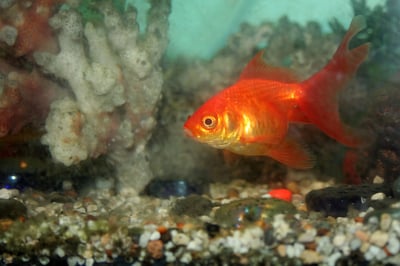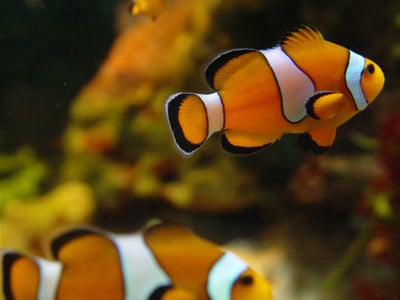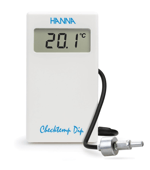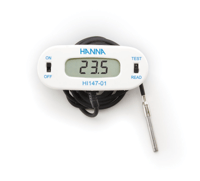 Aquarium temperature is often the first thing many home aquarium owners will test for and is critical for maintaining healthy fish. Different types of inhabitants live within different temperature ranges. Whether you are keeping a reef tank, goldfish, or tropical freshwater fish, knowing and maintaining your temperature is important for success.
Aquarium temperature is often the first thing many home aquarium owners will test for and is critical for maintaining healthy fish. Different types of inhabitants live within different temperature ranges. Whether you are keeping a reef tank, goldfish, or tropical freshwater fish, knowing and maintaining your temperature is important for success.
- Why Monitor Aquarium Temperature?
- Optimal Aquarium Temperature Ranges
- Acclimating New Livestock to Your Home Aquarium
- Equipment's Effects on Aquarium Temperature
- How to Monitor Your Aquarium's Temperature
Why Monitor Aquarium Temperature?
Aquarium temperature is often the first thing people test for in home aquariums and is critical for maintaining healthy metabolic functions in fish. Most fish are poikilothermic (meaning they don't regulate internal body temperature) but rather they rely on their environment.
Poikilothermic organisms function best within a designated temperature range, so aquarium temperatures outside a proper range can cause problems. Improper aquarium temperature can also lead to inadequate growth, respiratory or cardiac paralysis, and possibly death.
Keeping your aquarium's temperature stable is just as important as keeping it within an optimal range. A sudden decrease in aquarium temperature can hurt a fish’s immune system and raise the risk of it getting sick. Sudden increases in aquarium temperature can lead to a spike in metabolic activity, a shock to respiratory system, and coral bleaching.
Certain parasites, such as Cryptocaryon irritans or Ichthyophthirius multifiliis (more commonly known as "ick"), thrive in specific temperature ranges. This makes testing your aquarium temperature especially important when your fish are combating pathogens.
Knowing what the optimal temperature for your tank is dependent on a variety of factors, including where your organisms originate from and what their previous environments were.
Optimal Aquarium Temperature Ranges
Many species of home aquarium fish can tolerate a wide range of temperatures, such as goldfish who can live in temperatures around 40-80°F. Other organisms do best at a very narrow temperature range, like saltwater coral reef which thrives at aquarium temperatures between 76-84°F.
For tropical freshwater aquariums, temperature range depends on which species you are keeping. South American Discus require a temperature of 80-86°F while more common community tropical freshwater fish, such as tiger barbs, live in a general range of 76-80°F.
Acclimating New Livestock to Your Home Aquarium
When introducing livestock into a home aquarium, acclimation is an important step that everyone should follow. Acclimating is the process of slowly introducing fish, coral, or invertebrates into a new aquarium and adjusting them to your aquarium's water.
This is important because differences in water chemistries can stress aquarium livestock if they don't have enough time to adjust. The process varies depending on the sensitivity of the organisms you are acclimating.
Generally you will receive new aquarium livestock in a bag or container of water. To acclimate your new pet, let the bag float in your tank. This helps the water in the bag slowy adjust to match your aquarium's temperature.
To ensure proper acclimation, use an accurate digital thermometer to carefully monitor the temperature of both the aquarium water, as well as the water in the bag or container. Make sure there are no sudden spikes or drops in during the process.Hanna Tip: To acclimate for other variations in water chemistry in addition to temperature, you can slowly add aquarium water to the bag holding your new livestock. This can take anywhere from 15-60 minutes depending on the species. The drip method of acclimation is often used for sensitive organisms and reef tank inhabitants.
Equipment's Affects on Aquarium Temperature
There are many pieces of equipment in home aquariums which can affect or control temperature. Heaters are often a necessary component, but monitoring temperature is still necessary even if you have one installed. This is because over time heaters can easily fail, dramatically raising or lowering the aquarium temperature.
In addition, high output lights, pumps, or filtration equipment can all generate heat. You can control this unintended heating of the water by using aquarium chillers, which are used to lower temperature.
With so many pieces of equipment affecting the temperature of water, it's best to use an accurate thermometer to monitor aquairum temperature changes.
How to Monitor Your Aquarium's Temperature
There are a few different ways to monitor temperature in your home aquarium. Many heaters have temperature settings built in, but these can fail and are notoriously inaccurate; glass thermometers intended for aquariums are prone to breaking; and inexpensive digital thermometers will often fail after short periods of time and have no built-in calibration.
To get the most accurate temperature measurements, Hanna carries a line of Checktemp digital thermometers. With varying cable lengths and probe types, there is a highly accurate thermometer for any type of professional or home aquarium.
Our Checkfridge™ Remote Sensor Thermometer - HI147 and Checktemp Dip Digital Thermometer - HI98539, shown below, are great portable digital thermometers designed for reliable and accurate use. These models contain our exclusive CAL Check™ feature which confirms calibration on start-up, doing away with the time-consuming task of preparing an ice bath.
Hanna Tip: It's important to note that our temperature probes are made out of stainless steel. If they are continually left in salt water for long periods of time they will corrode. We recommend removing the probes after use in saltwater and rinsing them with freshwater.
Click the photos to compare!
Checktemp® Dip Digital Thermometer - HI98539
Checkfridge™ Remote Sensor Thermometer - HI147
Also check out these dual function pH pocket testers that also measure temperature.
- pHep® Waterproof Pocket pH Tester with 0.1 pH Resolution
- pHep®+ Waterproof Pocket pH Tester with 0.01 pH Resolution
- pHep®4 pH/Temperature Tester
- pHep®5 pH/Temperature Tester





